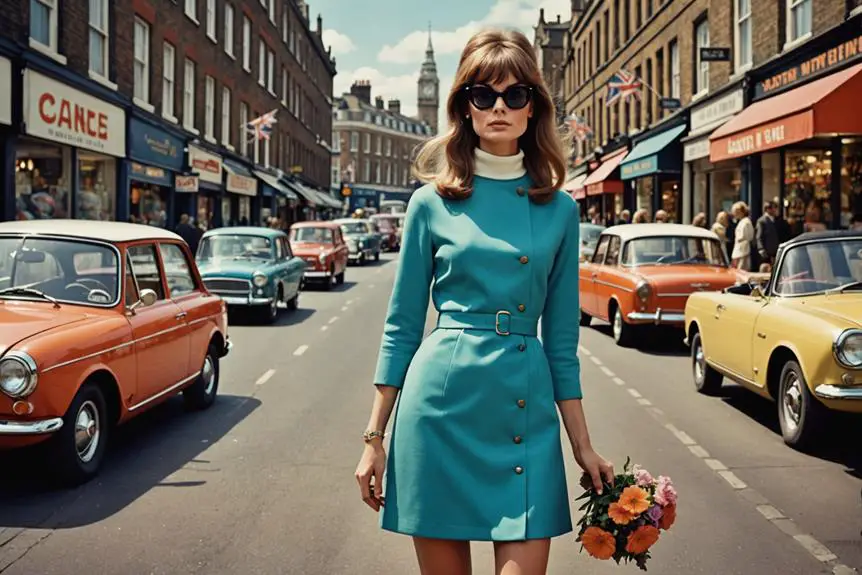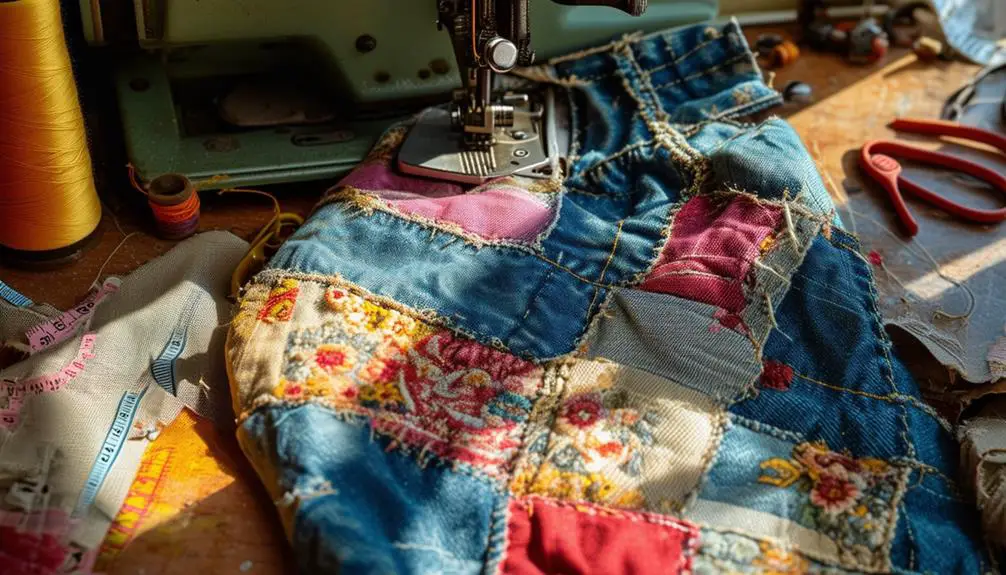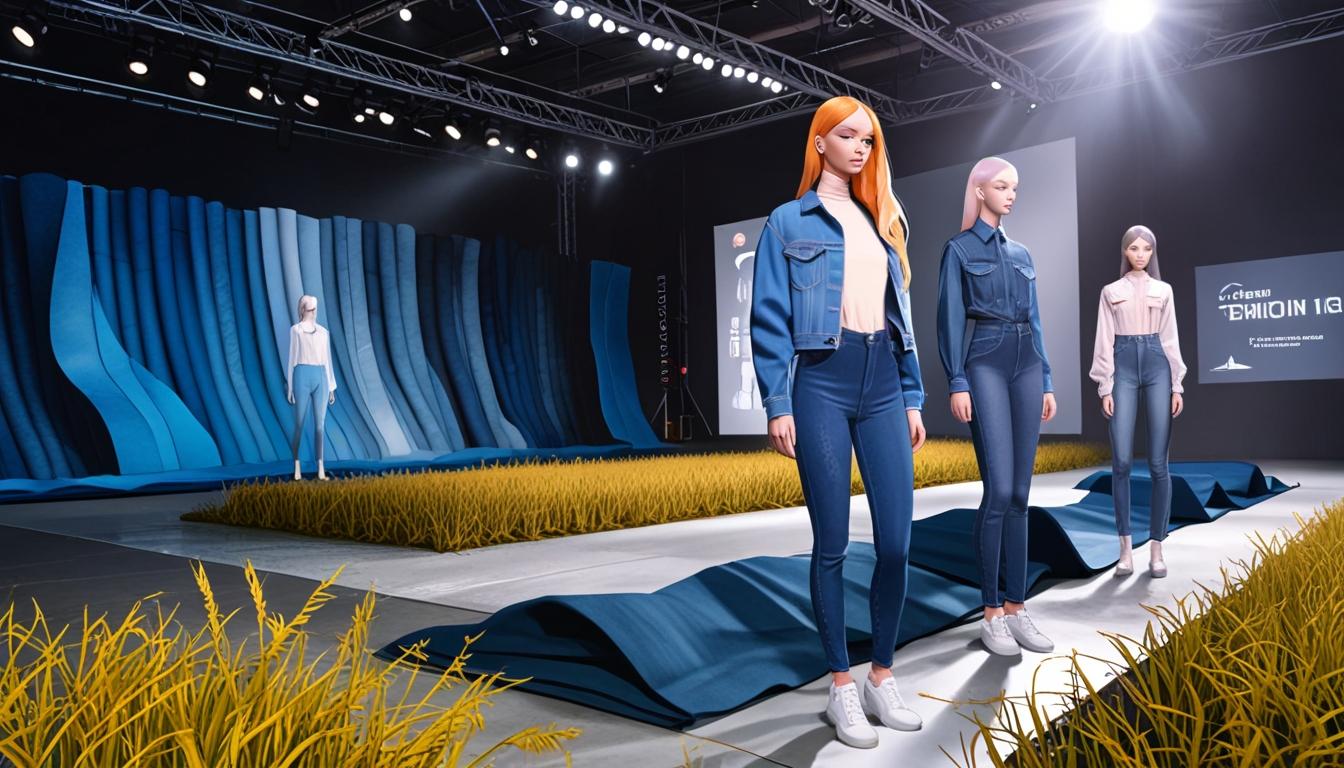When you think about the evolution of fashion in the 1960s, you can't ignore Jean Shrimpton and her groundbreaking moments that transformed the industry. Her 1965 Derby Day appearance, with its provocative shift dress and audacious hemline, sparked conversations about femininity and self-expression that still resonate today. As you explore her influence, consider how her partnership with iconic photographers helped shape a new aesthetic. What does this mean for today's fashion landscape, and how does Shrimpton's legacy continue to challenge norms? The answers might just surprise you.
Jean Shrimpton's Early Career
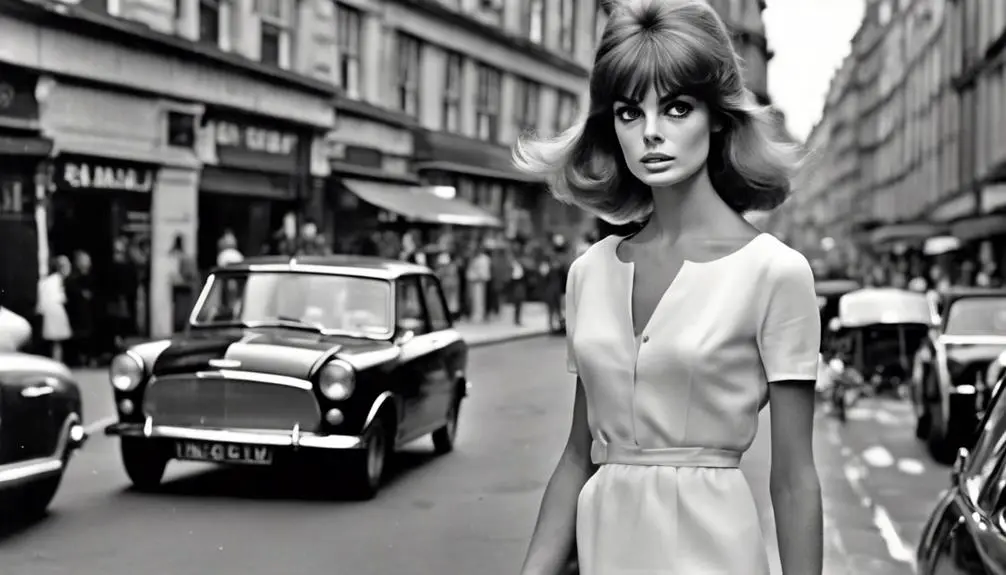
In the early 1960s, Jean Shrimpton emerged as a fashion sensation, enchanting audiences with her striking looks and effortless style. Discovered by photographer David Bailey in 1960, her early career took off rapidly, marking her as a key figure in the exciting Swinging Sixties. Shrimpton's breakthrough moment came when she became the face of a Kelloggs Corn Flakes advertisement, which solidified her popularity and showcased her appeal to a wide audience.
Her collaborations with iconic fashion photographers like Richard Avedon and Bert Stern highlighted her versatility and natural posing abilities, allowing her to shine in various styles and settings. By 1965, Shrimpton had reached international fame, becoming the highest-paid model in the world. This incredible journey not only transformed her career but also intertwined with her personal life, particularly her four-year relationship with David Bailey, which influenced her creative direction.
Throughout her early career, Shrimpton crafted numerous iconic fashion moments that defined an era. With each photograph, she captured the essence of a generation, leaving an enduring mark on the fashion landscape. Her story is a reflection of talent, determination, and the magnetic allure of Jean Shrimpton.
Defining the 1960s Aesthetic
Jean Shrimpton's iconic 1965 appearance in a simple white shift dress marked a revolutionary moment in fashion, showcasing the youthful boldness that defined the 1960s. This daring look, which shunned traditional accessories and challenged conservative styles, signaled a new era of self-expression for women. As you explore this shift dress revolution, you'll see how Shrimpton's influence not only shaped the decade's aesthetic but also inspired countless designers and liberated future generations.
Shift Dress Revolution
The iconic shift dress emerged as a defining symbol of the 1960s aesthetic, revolutionizing women's fashion in ways that resonated far beyond the runway. Jean Shrimpton's appearance in a simple white shift dress at the 1965 Melbourne Derby Day marked a moment that was nothing short of scandalous. With a hemline above the knee, her daring choice challenged the conservative styles that had dominated women's wardrobes for years. Designed in secrecy with dressmaker Colin Rolfe, this dress encapsulated the boldness of the era, aligning perfectly with the liberation and youthful spirit of the Swinging Sixties.
Shrimpton's decision to forgo traditional accessories like stockings, gloves, and a hat amplified her audacious look, making a declaration that fashion could be both daring and personal. The extensive media coverage that followed her outfit shifted public perceptions, paving the way for increased acceptance of bold styles and the global popularity of the miniskirt. Today, the white shift dress stands as a timeless staple, inspiring generations of designers and symbolizing an ongoing dialogue about personal expression in women's fashion. The shift dress isn't just a garment; it's a reflection of a transformative era in fashion history.
Youthful Boldness Emergence
Fashion during the 1960s burst forth with a vibrant energy, challenging norms and celebrating individuality. Jean Shrimpton emerged as a fashion icon during this dynamic decade, epitomizing the youthful boldness that defined the Swinging Sixties. Her unforgettable appearance at the 1965 Melbourne Cup, where she donned a scandalously short white shift dress, marked a significant cultural shift in women's fashion, symbolizing liberation and self-expression.
This moment not only showcased her willowy physique but also solidified the miniskirt as a staple in wardrobes everywhere, influenced by the era's rebellious spirit. Shrimpton's collaboration with renowned photographers like David Bailey captured the essence of this youthful rebellion, making her a defining figure in fashion history.
The media frenzy surrounding her Derby Day outfit ignited conversations about women's rights and the evolving landscape of fashion, encouraging women to embrace their individuality. Through her bold choices and striking looks, Shrimpton didn't just influence fashion; she played a vital role in the cultural shift of the 1960s, inspiring generations to celebrate their unique styles and challenge societal norms.
The Iconic Derby Day Appearance
At the 1965 Derby Day in Melbourne, Jean Shrimpton made waves with her groundbreaking style that challenged the era's conservative fashion norms. Dressed in a simple white shift dress cut above the knee, she became a media sensation, with her iconic appearance overshadowing the horse race itself. Shrimpton's choice to forgo stockings, a hat, and gloves in the sweltering heat shocked traditional racegoers and highlighted the cultural divide of the time.
This moment was pivotal, not just for Shrimpton, but for the entire 1960s fashion scene. Her bold statement popularized the miniskirt and inspired future trends. You can almost feel the excitement of the day with these three defining elements:
- The striking simplicity of her white shift dress that redefined elegance.
- The daring decision to embrace a carefree style, challenging conservative fashion.
- The immediate attention it garnered, launching Shrimpton into the spotlight.
Jean Shrimpton's Derby Day appearance was a celebration of youthful boldness and a reflection of the evolving landscape of women's fashion, marking a significant turn in the narrative of style and self-expression.
Media and Public Reactions
Jean Shrimpton's Derby Day appearance didn't just turn heads; it ignited a firestorm of reactions from the media and the public alike. Sporting a scandalous white shift dress that defied fashion norms, Shrimpton's look became the talk of the town. With no stockings or hat, she challenged societal expectations of women, sparking debates across the spectrum. While conservative figures expressed outrage, major publications like The Sun News-Pictorial lauded her boldness, leading to extensive media coverage that overshadowed even the horse race itself.
The public reactions ranged from shock to admiration, as many questioned the implications of Shrimpton's exposed skin on women's liberation. Editorials discussed how her daring choices signified a shift in fashion, inspiring younger women to embrace their individuality. Australian designer Zara Holt acknowledged this impact, noting how Shrimpton's style encouraged a more adventurous approach to fashion.
Over time, the initial backlash transformed into widespread celebration, solidifying Jean Shrimpton's status as a fashion icon. Her Derby Day appearance became a pivotal moment in the evolution of women's fashion, illustrating that sometimes, breaking the mold can lead to something truly remarkable.
Lasting Impact on Fashion
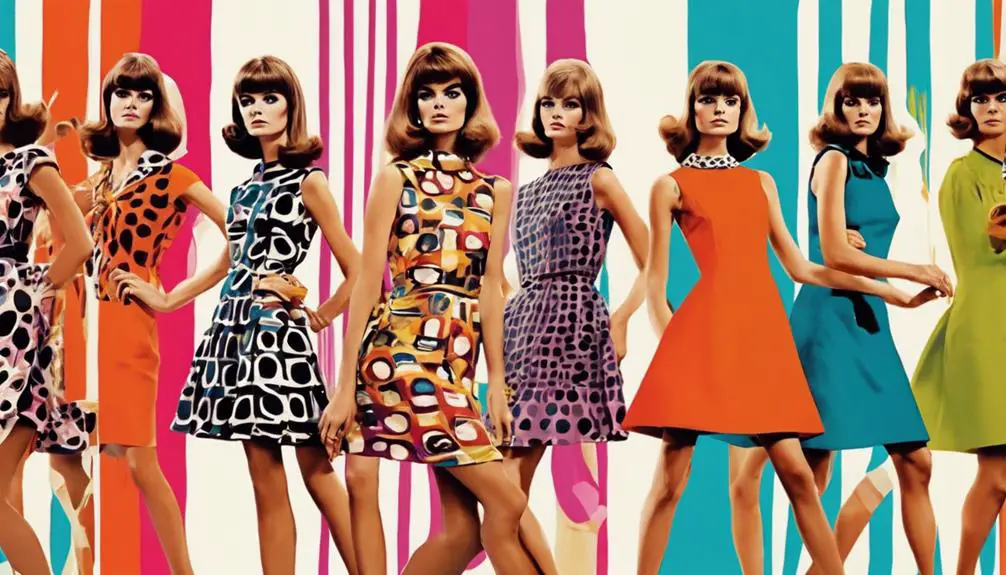
Jean Shrimpton didn't just change her wardrobe; she sparked a cultural shift in fashion that still influences designers today. Her iconic white shift dress and daring miniskirt choices liberated women's fashion from conservative norms, paving the way for future trends that celebrated individuality and self-expression. As you explore her lasting impact, you'll see how her bold style and collaboration with visionary photographers redefined not only fashion aesthetics but also the very notion of beauty in the industry.
Cultural Shift in Fashion
Shrimpton's groundbreaking appearance at the 1965 Derby Day in Melbourne ignited a cultural shift in fashion that resonated far beyond the confines of the event. Her daring above-the-knee white shift dress challenged the conservative fashion norms of the time, sparking conversations about women's rights and self-expression. This moment marked a turning point, as Jean Shrimpton became a symbol of freedom and individuality in the 1960s.
Consider the impact of her style:
- Miniskirt Mania: Shrimpton's outfit popularized the miniskirt, making it a global sensation.
- Redefined Beauty Standards: She moved away from the nip-waisted silhouettes of the 1950s, embracing a more youthful, natural aesthetic.
- Timeless Staple: The shift dress she wore has remained a beloved fashion item, representing liberation and modernity.
Influence on Future Designers
The iconic white shift dress worn at the 1965 Derby Day not only turned heads but also set the stage for a revolution in fashion design. Jean Shrimpton's daring choice broke away from traditional styles, inspiring designers to embrace shorter hemlines and the miniskirt, which quickly became a staple in women's fashion. Her leggy look didn't just capture attention; it sparked a cultural shift that encouraged a new standard for beauty and femininity.
Shrimpton's minimalist aesthetics emphasized simplicity and personal expression, motivating future designers to create collections that resonate with a liberated woman. This approach paved the way for modern interpretations of fashion—designers began exploring innovative silhouettes and bold choices that celebrated individuality. Furthermore, her collaborations with renowned photographers like David Bailey showcased how models could influence design through striking visual representation, further solidifying her impact.
The cultural significance of Shrimpton's fashion choices remains evident today, as they continue to inspire designers to push boundaries. It's thrilling to see how her legacy lives on, encouraging new generations to embrace boldness and redefine femininity in their own unique ways. Jean Shrimpton truly transformed the fashion landscape for the better!
Celebrating Shrimpton's Legacy
Celebrating the legacy of one of fashion's most influential figures, Jean Shrimpton, brings to light her remarkable contributions to the modeling world. As one of the original supermodels, her iconic appearance at the 1965 Melbourne Derby Day in that scandalous white shift dress marked a pivotal moment in fashion history, redefining beauty standards for generations to come.
Her influence can be felt in three significant ways:
- Liberation of Women's Fashion: Shrimpton's daring style challenged traditional norms, encouraging women to express themselves through fashion.
- Visual Narrative: Collaborations with renowned photographers like David Bailey and Richard Avedon shaped the aesthetic of an entire era, showcasing the supermodel as a cultural icon.
- Enduring Inspiration: Even today, Shrimpton's legacy inspires upcoming models and designers, reminding them that fashion is a powerful form of self-expression.
Her impact on the fashion industry is celebrated during significant anniversaries, such as her 72nd birthday, highlighting how her influence continues to resonate within contemporary fashion discourse. Jean Shrimpton remains a timeless figure, ensuring her legacy will not be forgotten.
Frequently Asked Questions
How Did Jean Shrimpton Influence Fashion?
Imagine a world where fashion bursts with color and rebellion. You see Shrimpton's style embodying minimalist aesthetics, shaping 1960s trends and runway revolution, leaving an indelible cultural impact as a supermodel of timeless elegance.
What Did Jean Shrimpton Do in Australia?
When Jean Shrimpton made her Australian debut, she sparked a fashion revolution. Her iconic photoshoots garnered immense media attention, reshaping public perception and leaving a lasting legacy that influenced style evolution and cultural impact for generations.
What Has Happened to Jean Shrimpton?
Jean's legacy continues to thrive as you explore Shrimpton's style and its impact on fashion evolution. Her iconic poses in photography reflect 1960s culture, while her model activism and collaborations shape media portrayal and personal life.
